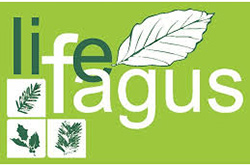FAGUS - Apennine forests: good practices to conjugate use and sustainability
LIFE11 NAT/IT/000135

Object
Techniques for creating microhabitats on dead wood.
PROJECT REFERENT
Di Santo Daniele
WEBSITE
Objective
To generate useful habitats to increase the diversity of birds and small mammals that carry out part of their life cycle inside the cavities of senescent or dead trees.
Good Practice Description
The good practice entails the selection of trees, possibly large and branchy, at least 20 m away from each other, to be used for the creation of habitats by creating nesting cavities and/or basal slits on the stem. Once selected, the trees must be clearly marked in the forest and georeferenced, then treated with specific techniques for the construction of cavities or slits.
The nesting cavities are made on the stem, at a height of 1-4 m from the ground, through the opening of holes of variable size in relation to the ornithological species to be housed,
The operation then takes place by performing the following steps:
a) four front cuts to delimit a wooden section and a side cut to intercept the front cuts to allow the extraction;
b) extraction of the wooden section;
c) reduction of the thickness of the extracted section and execution of the circular hole;
d) application and sealing of the wooden section back on the trunk.
The creation of basal slits takes place through cuts at the base of the stem from which a series of pockets are created, generally three, arranged in vertical succession and oblique, in order to favour water stagnation.
The techniques are quite simple but require expert and competent workers, specific equipment and training, and, as always, particular attention to safety rules.
Territorial Context
The good practice has been implemented in the Apennine beech forests in the Cilento (SA) and Gran Sasso and Monti della Laga National Parks. These are typically mountainous and foothill areas, characterised by the presence of small, inhabited centres, and by a general delay in the development of the infrastructural system.
Replicability conditions
The techniques for the creation of various types of habitats can be implemented wherever similar objectives and conditions are found. However, skilled workers, properly trained and equipped are necessary.
Dissemination material
From the LIFE GoProFor database, in the final part of the sheet, it is possible to download some material relating to the project, including the Layman's report in the technical manual entitled: "Manual of good practices for the management of habitats 9210* and 9220*", especially the actions C.7-C.8.


